上海交通大学:《面向对象软件工程 Software Engineering》课程教学资源(PPT课件讲稿)06. System Design-Decomposing the System
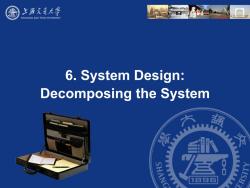
上游充通大学 SHANGHAI JIAO TONG UNIVERSITY 6.System Design: Decomposing the System 强 w 春 SHANG 1日日G
6. System Design: Decomposing the System

上游充通大¥ Outline SHANGHAI JIAO TONG UNIVERSITY Design System Design Activities Determine Design Goals System Design Concepts © Software Architecture Pattern Software Engineering
Software Engineering Outline Design System Design Activities Determine Design Goals System Design Concepts Software Architecture Pattern

上游充通大¥ SHANGHAI JIAO TONG UNIVERSITY 1.Design Software Engineering
Software Engineering 1. Design

上游充通大¥ SHANGHAI JIAO TONG UNIVERSITY 1.1 Design Methodology "There are two ways of constructing a software design:One way is to make it so simple that there are obviously no deficiencies,and the other way is to make it so complicated that there are no obvious deficiencies. C.A.R.Hoare Software Engineering
Software Engineering 1.1 Design Methodology “There are two ways of constructing a software design: One way is to make it so simple that there are obviously no deficiencies, and the other way is to make it so complicated that there are no obvious deficiencies.” - C.A.R. Hoare
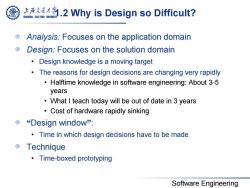
上大名.2 Why is Design so Difficult? SHANGHAI JIAO TONG UNIVERSITY Analysis:Focuses on the application domain Design:Focuses on the solution domain Design knowledge is a moving target The reasons for design decisions are changing very rapidly Halftime knowledge in software engineering:About 3-5 years What I teach today will be out of date in 3 years Cost of hardware rapidly sinking “Design window": Time in which design decisions have to be made Technique Time-boxed prototyping Software Engineering
Software Engineering 1.2 Why is Design so Difficult? Analysis: Focuses on the application domain Design: Focuses on the solution domain • Design knowledge is a moving target • The reasons for design decisions are changing very rapidly • Halftime knowledge in software engineering: About 3-5 years • What I teach today will be out of date in 3 years • Cost of hardware rapidly sinking “Design window”: • Time in which design decisions have to be made Technique • Time-boxed prototyping
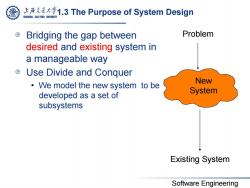
上充大1.3 The Purpose of System Design SHANGHAI JIAO TONG UNIVERSITY Bridging the gap between Problem desired and existing system in a manageable way © Use Divide and Conquer New We model the new system to be developed as a set of System subsystems Existing System Software Engineering
Software Engineering 1.3 The Purpose of System Design Bridging the gap between desired and existing system in a manageable way Use Divide and Conquer • We model the new system to be developed as a set of subsystems Problem Existing System New System

上游充通大学 SHANGHAI JIAO TONG UNIVERSITY 1.4 Viewpoint Change Do the right Do the things things right What How Software Engineering
Software Engineering 1.4 Viewpoint Change Do the right things Do the things right What How
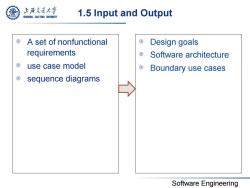
上游充通大¥ SHANGHAI JIAO TONG UNIVERSITY 1.5 Input and Output A set of nonfunctional Design goals requirements 国 Software architecture 国 use case model Boundary use cases sequence diagrams Software Engineering
Software Engineering 1.5 Input and Output A set of nonfunctional requirements use case model sequence diagrams Design goals Software architecture Boundary use cases
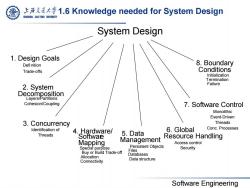
上克通大1.6 Knowledge needed for System Design SHANGHAI JIAO TONG UNIVERSITY System Design 1.Design Goals Defi nition 8.Boundary Trade-offs Conditions Initialization T ermination 2.System Failure Decomposition Layers/Partitions Cohesion/Coupling 7.Software Control Monolithic Event-Driven 3.Concurrency Threads Identification of 4.Hardware/ 6.Global Conc.Processes Threads Softwae 5.Data Mapping Management Resource Handling Access control Special purpose Persistent Objects Buy or Build Trade-off Files Security Allocation Databases Data structure Connectivity Software Engineering
Software Engineering 1.6 Knowledge needed for System Design System Design 2. System Layers/Partitions Cohesion/Coupling 5. Data 1. Design Goals Defi nition T rade-of fs 4. Hardware/ Special purpose Software Buy or Build Trade-off Allocation Connectivity 3. Concurrency Data structure Persistent Objects Files Databases Management Access control Security 6. Global Resource Handling 8. Boundary Conditions Initialization T ermination Failure Decomposition Mapping 7. Software Control Identification of Threads Monolithic Event-Driven Threads Conc. Processes
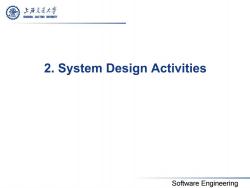
上游充通大¥ SHANGHAI JIAO TONG UNIVERSITY 2.System Design Activities Software Engineering
Software Engineering 2. System Design Activities
按次数下载不扣除下载券;
注册用户24小时内重复下载只扣除一次;
顺序:VIP每日次数-->可用次数-->下载券;
- 上海交通大学:《面向对象软件工程 Software Engineering》课程教学资源(PPT课件讲稿)05. Analysis.pdf
- 上海交通大学:《面向对象软件工程 Software Engineering》课程教学资源(PPT课件讲稿)04. Requirements Elicitation.pdf
- 上海交通大学:《面向对象软件工程 Software Engineering》课程教学资源(PPT课件讲稿)03. Project Organization and Management.pdf
- 上海交通大学:《面向对象软件工程 Software Engineering》课程教学资源(PPT课件讲稿)02. Modeling with UML.pdf
- 上海交通大学:《面向对象软件工程 Software Engineering》课程教学资源(PPT课件讲稿)11.Testing.pptx
- 上海交通大学:《面向对象软件工程 Software Engineering》课程教学资源(PPT课件讲稿)10.Mapping Models to Code.pptx
- 上海交通大学:《面向对象软件工程 Software Engineering》课程教学资源(PPT课件讲稿)01. Introduction to Software Engineering.pptx
- 上海交通大学:《面向对象软件工程 Software Engineering》课程教学资源(PPT课件讲稿)00. Course Introduction.pptx
- 上海交通大学:《程序设计思想与方法》课程教学资源(PPT课件讲稿)chapter03 数值计算.ppt
- 上海交通大学:《程序设计思想与方法》课程教学资源(PPT课件讲稿)chapter02 程序基本构件.ppt
- 上海交通大学:《程序设计思想与方法》课程教学资源(PPT课件讲稿)chapter01 课程简介、计算机与程序.ppt
- 《程序设计思想与方法》课程教学资源(课程参考书PDF电子版)How to Think Like a Computer Scientist Learning with Python.pdf
- 《程序设计思想与方法》课程教学资源(课程参考书PDF电子版)Python Programming:An Introduction to Computer Science(2002版).pdf
- 《程序设计思想与方法》课程教学资源(课程参考书PDF电子版)PYTHON programming:AN INTRODUCTION TO COMPUTER SCIENCE(JOHN ZELLE).pdf
- 上海交通大学:《程序设计思想与方法》课程教学资源(上机课)第二次上机_第二次上机题目_11.1.doc
- 《Embedded System LAB》教学资源:KEIL Tools by ARM Getting Startedu Creating Applications withμVision®(uv4).pdf
- 上海交通大学:《程序设计思想与方法》课程教学资源(PPT课件讲稿)chapter9 模拟与设计.ppt
- 上海交通大学:《程序设计思想与方法》课程教学资源(PPT课件讲稿)chapter11 数据集合体.ppt
- 上海交通大学:《程序设计思想与方法》课程教学资源(PPT课件讲稿)Chapter10 类的定义.ppt
- 上海交通大学:《程序设计思想与方法》课程教学资源(PPT课件讲稿)chapter08 控制结构(循环语句).ppt
- 上海交通大学:《面向对象软件工程 Software Engineering》课程教学资源(PPT课件讲稿)07.System Design-Addressing Design Goals.pdf
- 上海交通大学:《面向对象软件工程 Software Engineering》课程教学资源(PPT课件讲稿)08. Object Design-Reusing Pattern Solutions.pptx
- 上海交通大学:《面向对象软件工程 Software Engineering》课程教学资源(PPT课件讲稿)09. Object Design-Specifying Interfaces.pptx
- 上海交通大学:《面向对象软件工程 Software Engineering》课程教学资源_About Practical Course.docx
- 上海交通大学:《面向对象软件工程 Software Engineering》课程教学资源_Review Guideline SOFTWARE ENGINEERING.pdf
- 上海交通大学:《面向对象软件工程 Software Engineering》课程教学资源(作业)0.Plan_4. 计划阶段指南.docx
- 上海交通大学:《面向对象软件工程 Software Engineering》课程教学资源(作业)0.Plan_可行性研究报告.doc
- 上海交通大学:《面向对象软件工程 Software Engineering》课程教学资源(作业)0.Plan_项目开发计划.doc
- 上海交通大学:《面向对象软件工程 Software Engineering》课程教学资源(作业)1.Define_小组作业2.docx
- 上海交通大学:《面向对象软件工程 Software Engineering》课程教学资源(作业)1.Define_词汇表.docx
- 上海交通大学:《面向对象软件工程 Software Engineering》课程教学资源(作业)1.Define_软件需求规约.docx
- 上海交通大学:《面向对象软件工程 Software Engineering》课程教学资源(作业)1.Define_需求定义阶段指南.docx
- 上海交通大学:《面向对象软件工程 Software Engineering》课程教学资源(作业)2.Analysis_分析阶段指南.docx
- 上海交通大学:《面向对象软件工程 Software Engineering》课程教学资源(作业)2.Analysis_软件需求规约.docx
- 上海交通大学:《面向对象软件工程 Software Engineering》课程教学资源(作业)3.Design_设计阶段指南.docx
- 上海交通大学:《面向对象软件工程 Software Engineering》课程教学资源(作业)3.Design_软件架构文档.docx
- 上海交通大学:《面向对象软件工程 Software Engineering》课程教学资源(作业)3.Design_软件设计模型.docx
- 上海交通大学:《面向对象软件工程 Software Engineering》课程教学资源(作业)4. Build_构造阶段指南.docx
- 上海交通大学:《面向对象软件工程 Software Engineering》课程教学资源(作业)4. Build_模块开发卷宗.docx
- 上海交通大学:《面向对象软件工程 Software Engineering》课程教学资源(作业)5.Test&Deploy&Close_交付清单.docx
